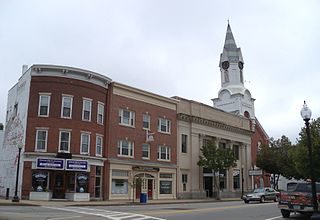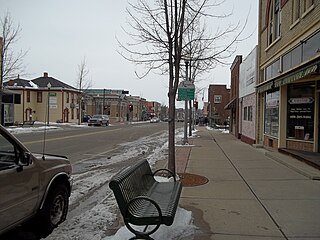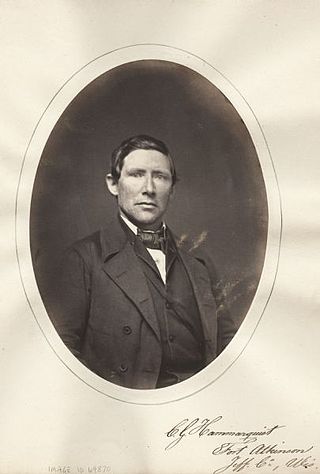Related Research Articles

Hastings is a city and the county seat of Adams County, Nebraska, United States. The population was 25,152 at the 2020 census.

Rochester is a city in Strafford County, New Hampshire, United States. The population was 32,492 at the 2020 census. In addition to the downtown area, the city contains the villages of East Rochester, Gonic, and North Rochester. Rochester is home to Skyhaven Airport and part of Baxter Lake.

Portage is a city in and the county seat of Columbia County, Wisconsin, United States. The population was 10,581 at the 2020 census, making it the largest city in Columbia County. The city is part of the Madison Metropolitan Statistical Area.

The Town of Albion is located in Dane County, Wisconsin, United States. The population was 2,069 at the 2020 Census. The unincorporated communities of Albion, Highwood, Hillside, and Indian Heights are located in the town.

Stoughton is a city in Dane County, Wisconsin, United States. It straddles the Yahara River about 20 miles southeast of the state capital, Madison. Stoughton is part of the Madison Metropolitan Statistical Area. As of the 2020 census, the population was 13,173.

Edgerton is a city in Rock County and partly in Dane County in the U.S. state of Wisconsin. The population was 5,945 at the 2020 census. Of this, 5,799 were in Rock County, and 146 were in Dane County. Known locally as "Tobacco City U.S.A.," because of the importance of tobacco growing in the region, Edgerton continues to be a center for the declining tobacco industry in the area.

Jacques Marquette, S.J., sometimes known as Père Marquette or James Marquette, was a French Jesuit missionary who founded Michigan's first European settlement, Sault Sainte Marie, and later founded Saint Ignace. In 1673, Marquette, with Louis Jolliet, an explorer born near Quebec City, was the first European to explore and map the northern portion of the Mississippi River Valley.

Carroll University is a private university affiliated with the Presbyterian Church (USA) and located in Waukesha, Wisconsin. Established in 1846, Carroll was Wisconsin's first four-year institution of higher learning.
Williston Northampton School is a private, co-educational, day and boarding college-preparatory school in Easthampton, Massachusetts, United States. It was established in 1841.

The University of Wisconsin–Stevens Point is a public university in Stevens Point, Wisconsin. Established in 1894, it is part of the University of Wisconsin System. UW-Stevens Point grants associate, baccalaureate, and master's degrees, as well as doctoral degrees in audiology and educational sustainability. As of 2018, UW-Stevens Point has merged with UW-Stevens Point at Wausau and UW-Stevens Point at Marshfield. The 406-acre (164 ha) main campus includes the 280-acre (113 ha) Schmeeckle Reserve on the north side of the Campus. There are 15 academic buildings, and 13 Residence Halls.

James Ole Davidson was a Norwegian American immigrant and the 21st governor of the U.S. state of Wisconsin. He also served as lieutenant governor of Wisconsin and state treasurer.

Fort Winnebago was a 19th-century fortification of the United States Army located on a hill overlooking the eastern end of the portage between the Fox and Wisconsin Rivers east of present-day Portage, Wisconsin. It was the middle one of three fortifications along the Fox-Wisconsin Waterway that also included Fort Howard in Green Bay, Wisconsin and Fort Crawford in Prairie du Chien, Wisconsin. Fort Winnebago was constructed in 1828 as part of an effort to maintain peace between white settlers and the region's Native American tribes following the Winnebago War of 1827. The fort's location was chosen not only because of its proximity to the site of Red Bird's surrender in the Winnebago War, but also because of the strategic importance of the portage on the Fox-Wisconsin Waterway, a heavily traveled connection between the Great Lakes and the Mississippi River. Fort Winnebago's location near the portage allowed it to regulate transportation between the lakes and the Mississippi.

Edward Lee Greene was an American botanist known for his numerous publications including the two-part Landmarks of Botanical History and the describing of over 4,400 species of plants in the American West.

Dorchester Academy was a school for African-Americans located just outside Midway, Georgia. Operating from 1869 to 1940, its campus, of which only the 1935 Dorchester Academy Boys' Dormitory survives, was the primary site of the Southern Christian Leadership Conference's Citizen Education Program. This program, ran here from 1961 to 1970, worked toward attaining equality for blacks in the American South by teaching them their rights and helping them acquire the knowledge necessary to become registered voters by passing the required test. The dormitory building was designated a U.S. National Historic Landmark in 2006 for its later role in the American civil rights movement, and for its association with activist Septima Poinsette Clark, who oversaw the education program. The campus, which includes several later buildings, is now a museum and research center.

Thure Ludwig Theodor Kumlien was a Swedish-American ornithologist, naturalist, and taxidermist. A contemporary of Thoreau, Audubon, and Agassiz, he contributed much to the knowledge of the natural history of Wisconsin and its birds. He collected and shipped specimens to many investigators in the United States and abroad. He taught botany and zoology, as well as foreign languages, at Albion Academy, and was particularly regarded as an expert in the identification of birds’ nests.

The University of Wisconsin–Madison is a public land-grant research university in Madison, Wisconsin. Founded when Wisconsin achieved statehood in 1848, UW–Madison is the official state university of Wisconsin and the flagship campus of the University of Wisconsin System. It was the first public university established in Wisconsin and remains the oldest and largest public university in the state. It became a land-grant institution in 1866. The 933-acre (378 ha) main campus, located on the shores of Lake Mendota, includes four National Historic Landmarks. The university also owns and operates the 1,200-acre (486 ha) University of Wisconsin–Madison Arboretum, located 4 miles (6.4 km) south of the main campus, which is also a National Historic Landmark.

Albion is an unincorporated community located in the Town of Albion, Dane County, Wisconsin, United States.

Charles G. Hammarquist was an American farmer, merchant and postmaster from Busseyville, Wisconsin, who served in the Wisconsin State Assembly.

Aaron Ludwig Kumlien was an American ornithologist and the oldest son of Thure Kumlien. He took part in the Howgate Polar Expedition 1877-78 and collected a large number of bird specimens which led to the discovery of several new species including what is now known as Kumlien's gull.